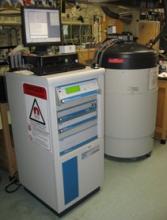The MRL Chemistry Facility has a new analytical instrument called a Physical Properties Measurement System (PPMS). It measures DC Resistivity, AC Transport (AC Resistivity, Hall Coefficient, I-V Curve, & Critical Current for superconductors), and Heat Capacity for small samples under user controlled magnetic field, pressure, gas composition, and temperature. The magnetic field may be programmed anywhere from 0 to +/- 70,000 Oersted and the sample's temperature can be programmed from 1.9 to 400 K. Users select and may program the excitation voltage, frequency, and current. Users can also set an upper limit on the current to preserve samples.
The MRL can test your samples or train users to run the instruments directly. The instrument is straightforward to use.
The Quantum Design AC Transport Measurement System (ACT) option incorporates a precision current source and a precision voltmeter. Both have a resolution of 0.02 µA and a maximum current of 2 A. This setup can support several different types of electrical transport current measurements, including measurements that require ramping a DC current. Measurements are typically made by passing a known current through the sample and measuring the voltage drop across the sample. The frequency range is from 1 Hz to 1 kHz and DC. The current capacity is from 10 mA to 2A with 500 mA continuous operation.
The ACT option uses the Model 7100 Controller to make four types of electrical transport current measurements:
Resistivity, I-V curve, and critical current measurements measure the resistive voltage of the sample. I-V curve and critical current measurements are basically variants of a resistivity measurement. All three of these measurement types require the same lead connections to the sample, typically 4 wire. Hall coefficient measurements, however, measure the sample’s Hall voltage and usually employ a five-wire configuration for the sample lead connections.
Resistivity Option
The Resistivity option for the PPMS adds a configurable resistance bridge board, called the user bridge board, to the main Model 6000 PPMS Controller. The Resistivity option can report resistance as well as resistivity, conductance, and conductivity; but only for DC excitation.
Heat capacity is a very useful measurement for many fields of physics and chemistry. The measurement of the heat capacity of solids can provide considerable information about the lattice properties, phase transitions, electronic, and even magnetic properties of materials. Heat capacity measurements, particularly when taken at temperatures that are well below the Debye temperature, directly probe the electronic and magnetic energy levels of a material and hence allow comparisons between theory and experiment. While electronic transport measurements, such as resistivity, are substantially more common, the link between experiment and theory is not always as clear as it is in a heat capacity measurement. Any statistical theory of matter involves computing the density of states and energy levels; these computations naturally lead to predictions of heat capacity numbers.
The actual measurement uses the Model 6500 controller and is a fully automated relaxation heat capacity measurement. It uses the sophisticated two tau model, with built in background subtraction of heat capacities not due to the sample. Traditionally heat capacity was very difficult measurement, but the PPMS automated system makes it much easier.
Thermal Transport Option
The Thermal Transport Option for the PPMS utilizes existing hardware to add the ability to measure the thermal conductivity, the Seebeck coefficient, and the electrical resistivity for a sample. With all of this information the Thermoelectric Figure of Merit can be calculated.
It works with the placement of the sample on multiple temperature sensors and a heater. A measured amount of heat is applied and the rate at which the samples heats as a function of distance from the heater is measured directly.
PPMS Option Descriptions
PPMS Brochure
ACT Option for PPMS
Heat Capacity Option
Thermal Transport Option
PPMS Manuals
PPMS ACT Manual
PPMS Resistivity Manual
PPMS Heat Capacity Manual
PPMS TTO Manual
PPMS MultiVu Manual
Quantum Design has a good description of this system and what it can do at http://www.qdusa.com/products/ppms.html.
